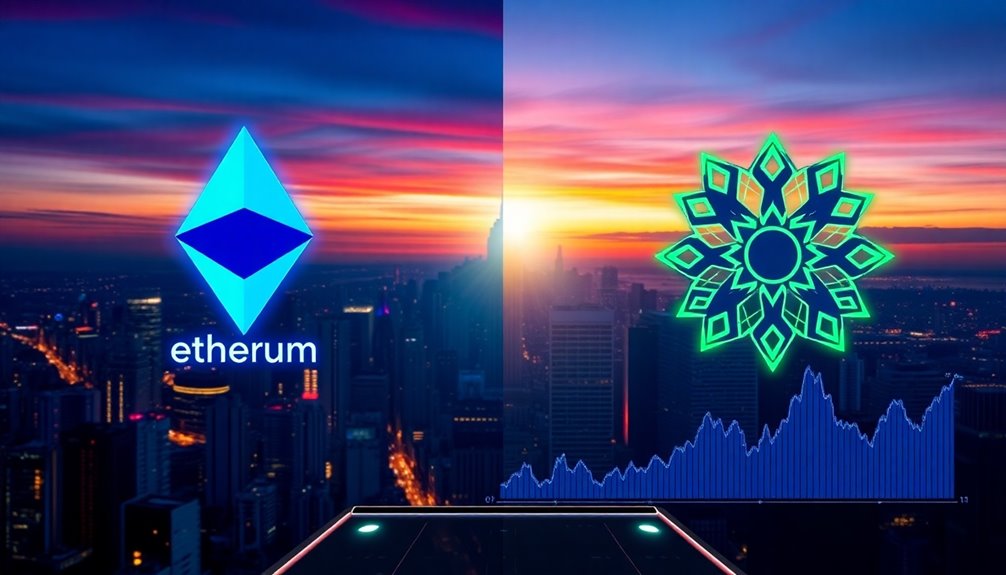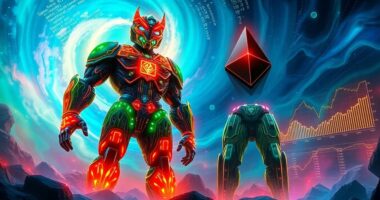Yes, Solana and Ethereum can compete, as they each have unique strengths. Solana boasts incredibly fast transaction speeds and low fees, while Ethereum shines in smart contract complexity and a large developer community. However, Lightchain AI is stepping in with innovative solutions like its Proof of Intelligence mechanism, aiming to lead in AI and blockchain integration. This could alter the competitive landscape significantly. Both ecosystems will need to adapt to emerging technologies and user demands to stay relevant. If you're curious about how these dynamics will unfold, there's much more to explore regarding their potential future.
Key Takeaways
- Solana's transaction speeds and low fees significantly outperform Ethereum, making it an attractive option for developers and users in decentralized applications.
- Ethereum's robust ecosystem and continuous upgrades are essential for maintaining its dominance in DeFi and NFTs despite increasing competition.
- Lightchain AI's upcoming mainnet launch in 2025 introduces a new competitor with innovative Proof of Intelligence consensus for various sectors.
- Both Solana and Ethereum must innovate and adapt to sustain their market positions amidst growing developer interest in alternative blockchain platforms.
- The competitive landscape may evolve through collaborations and technological breakthroughs, impacting the future dynamics between Solana, Ethereum, and Lightchain AI.
Overview of Solana and Ethereum

When comparing blockchain platforms, Solana and Ethereum represent two distinct approaches to decentralized technology.
Solana utilizes a proof-of-history (PoH) and proof-of-stake (PoS) consensus mechanism, enabling high transaction speeds of up to 710,000 transactions per second under optimal conditions. It emphasizes liveness, ensuring continuous functionality while processing transactions rapidly. Additionally, Solana's mempool-less protocol allows for handling 100,000 transactions in seconds, further enhancing its efficiency.
In contrast, Ethereum relies on a distributed ledger and a consensus model that validates transactions through a network of automated programs, processing state-altering transactions roughly every 12 seconds.
Both platforms support smart contracts, but Solana's architecture is designed for scalability, while Ethereum focuses on established methods that prioritize security and decentralized application development.
Your choice between them hinges on your specific needs in the decentralized ecosystem.
Strengths of Solana

Although many blockchain platforms vie for attention, Solana stands out due to its impressive strengths.
With the ability to process thousands of transactions per second, it boasts real-world performance of 4,000 to 4,500 TPS, peaking at 65,000 TPS. Its efficient architecture combines Proof of History and Proof of Stake, enhancing scalability.
You'll also appreciate Solana's low transaction fees, often less than $0.01, making it accessible for developers and users alike. Fast transaction speeds, with confirmations in seconds, support high-frequency trading and gaming applications.
Plus, an expanding ecosystem, fueled by community initiatives and grants, attracts innovative projects, ensuring Solana remains a competitive player in the blockchain landscape.
Strengths of Ethereum

Ethereum's strengths make it a formidable competitor in the blockchain space.
You'll appreciate its ability to support complex smart contracts, enabling a thriving ecosystem of decentralized applications, including DeFi and NFTs.
Its robust global development community continually enhances the network's security and promotes innovation. Additionally, this community's contributions help address ongoing scalability issues, ensuring that Ethereum remains competitive during peak demand.
The transition to Ethereum 2.0, with its proof-of-stake model, not only boosts scalability but also significantly reduces energy consumption, paving the way for a more sustainable future.
Layer 2 scaling solutions like Optimistic and zk-Rollups improve transaction speed and efficiency, enhancing user experience.
Finally, Ethereum's decentralization ensures security and resilience, making it less vulnerable to attacks while fostering user trust through continuous upgrades and improvements.
Lightchain AI's Unique Approach

Lightchain AI brings a fresh perspective to blockchain technology with its innovative approach that leverages artificial intelligence.
By introducing the Proof of Intelligence (PoI) consensus mechanism, it rewards nodes for valuable AI computations, making the process efficient and scalable. The project targets dynamic sectors such as healthcare, finance, and creative industries, showcasing its diverse application potential.
You'll appreciate the community-driven governance model, which empowers token holders with a voice in decision-making and fosters collaborative innovation.
Additionally, Lightchain AI's deflationary tokenomics ensures scarcity by burning tokens with each transaction, driving demand and promoting sustainable growth.
This unique blend of features positions Lightchain AI as a promising contender in the evolving blockchain landscape.
Lightchain AI's Market Performance

In just a short time, Lightchain AI has made significant strides in the market, showcasing impressive performance that captures investor attention.
With over $7 million raised during its presale at a token price of just $0.004, it allocated 40% of its 10 billion tokens for early investors. This low entry price has driven strong market confidence and interest, outshining Ethereum and Solana in terms of market enthusiasm. Additionally, the potential for tax-deferred growth in investments often attracts savvy investors looking for long-term gains.
Currently priced at $0.004875, there's potential for significant price surges upon exchange listings. Additionally, the maximum token supply capped at 10 billion ensures scarcity, further enhancing its appeal to investors.
Lightchain AI's decentralized governance and applications across industries like finance and healthcare enhance its competitive edge, positioning it for substantial returns and greater utility compared to its rivals. Investors are increasingly recognizing its potential.
Future of AI-Blockchain Integration

As the landscape of technology evolves, the integration of AI and blockchain is poised to redefine data management and security.
You'll find that enhanced data security is a key benefit, with immutable storage ensuring the reliability of AI training data. Blockchain facilitates encrypted data sharing, fostering trust among organizations while AI algorithms predict vulnerabilities, further protecting sensitive information. The integration of AI and blockchain enhances data integrity, ensuring that AI model training is based on reliable and accurate datasets.
The improved data integrity is another advantage, as AI verifies historical data accuracy before it's stored on the blockchain.
Additionally, scalable solutions like layer 2 innovations and efficient consensus mechanisms enhance performance, addressing current bottlenecks.
Finally, AI's ability to automate data translation between blockchains promotes interoperability, enabling seamless collaboration across various sectors and expanding the potential of AI-blockchain ecosystems.
Competitive Landscape Analysis

While the competition between Solana and Ethereum intensifies, understanding their respective strengths and weaknesses can help you navigate the evolving landscape of blockchain technology.
Solana boasts transaction speeds that are 3,000% faster than Ethereum, with daily active users increasing by 1,300%. Its transaction fees are nearly 5 million percent cheaper, offering a significant advantage in scalability. This enhanced efficiency positions Solana as a strong competitor to Ethereum.
However, Ethereum maintains a much larger market capitalization at over $313 billion compared to Solana's $70.6 billion, making it a more established choice for institutional investors.
While retail interest in Solana grows, institutional hesitance persists. Emerging competitors like Lightchain AI also introduce new dynamics, potentially reshaping the competitive landscape further.
Your investment strategy should consider these factors carefully.
Predictions for Market Evolution

Given the rapid evolution of blockchain technology, predictions for market evolution are shaped by several key factors influencing both Solana and Ethereum's trajectories.
Solana's prospects look promising, with price predictions soaring to $600-$1,000 by 2025, driven by its fast transactions and a growing developer base. BlockDAG's strategic growth could also pose a challenge to Solana as it gains traction in the blockchain space.
Meanwhile, Ethereum maintains its market strength through ongoing technical advancements and leadership in DeFi and NFTs.
However, it must contend with rising competition from Solana and innovative projects like Lightchain AI, which is set to launch its mainnet in 2025.
Frequently Asked Questions
What Are the Main Differences Between Pow and Poh?
When you compare Proof of Work (PoW) and Proof of History (PoH), you'll notice key differences.
PoW relies on computational power to validate transactions, ensuring high security but consuming vast energy.
In contrast, PoH timestamps transactions, enhancing efficiency and scalability without the energy demands of PoW.
You benefit from faster and cheaper transactions with PoH, while PoW offers proven security but struggles with speed and sustainability.
Each method has its unique strengths and weaknesses.
How Do Transaction Fees Affect User Adoption?
Imagine standing at a toll booth, deciding which road to take.
Lower transaction fees are like open highways, inviting you to drive faster. When you see Solana's average fee of just $0.036 compared to Ethereum's much higher costs, you're naturally drawn to the more affordable option.
This cost-effectiveness boosts user adoption, as people prefer platforms that don't drain their wallets, leading to a shift in how you choose to engage with blockchain technology.
What Role Do Developers Play in Blockchain Ecosystems?
Developers play a crucial role in blockchain ecosystems by creating and maintaining applications that drive user engagement.
You're responsible for implementing token standards, customizing functionalities, and ensuring interoperability across different networks.
Your skills in smart contract development automate processes like ownership transfers and revenue sharing, enhancing efficiency.
How Can Blockchain Technology Enhance Supply Chain Management?
You might think supply chains are already efficient, but blockchain's here to prove you wrong.
It enhances management by providing real-time tracking, ensuring data integrity with its immutable ledger, and automating processes that cut delays and costs.
You get increased transparency, allowing everyone to verify transactions, which builds trust among stakeholders.
Plus, with tamper-proof records, fraud becomes a relic of the past.
Suddenly, a once-complex system turns into a streamlined, reliable operation.
What Are the Risks of Investing in New Blockchain Projects?
When investing in new blockchain projects, you face several risks.
Regulatory uncertainty can lead to legal challenges and compliance issues.
Smart contract vulnerabilities might result in coding errors, leading to financial losses.
Security breaches could expose your data and assets to theft.
Market volatility creates unpredictable price swings, increasing your investment risks.
Lastly, operational risks from software bugs can undermine project integrity, putting your investment in jeopardy.
Always conduct thorough research before diving in.
Conclusion
In the race between Solana and Ethereum, it's clear that both have their unique strengths. However, Lightchain AI's innovative approach could shake things up, potentially giving it the edge. As AI and blockchain continue to intertwine, staying ahead of the curve is crucial. You might say it's anyone's game, but with the right moves, Lightchain AI could emerge as a front-runner. Keep an eye on this evolving landscape; the best is yet to come!









